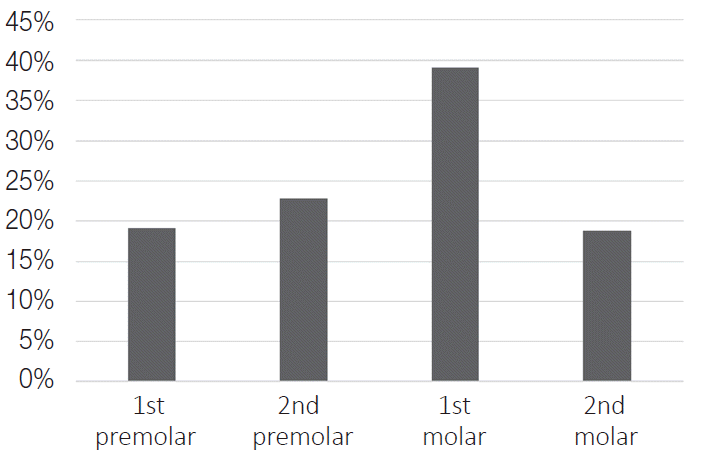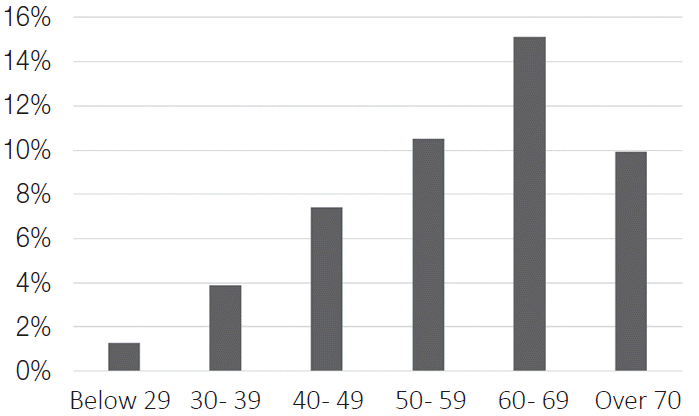1. Mjor IA. 2001; Pulp-dentin biology in restorative dentistry. Part 5: Clinical management and tissue changes associated with wear and trauma. Quintessence Int. 32:771–88. PMID:
11820046.
2. Wood I, Jawad Z, Paisley C, Brunton P. 2008; Non-carious cervical tooth surface loss: a literature review. J Dent. 36:759–66. DOI:
10.1016/j.jdent.2008.06.004. PMID:
18656296.
3. Miller WD. 1907; Experiments and observations on the wasting of tooth tissue variously designated as erosion, abrasion, chemical abrasion, denudation, etc. Dent Cosm. 49:1–23.
4. Lee WC, Eakle WS. 1984; Possible role of tensile stress in the etiology of cervical erosive lesions of teeth. J Prosthet Dent. 52:374–80. DOI:
10.1016/0022-3913(84)90448-7. PMID:
6592336.
6. Goel VK, Khera SC, Ralston JL, Chang KH. 1991; Stresses at the dentinoenamel junction of human teeth-a finite element investigation. J Prosthet Dent. 66:451–9. DOI:
10.1016/0022-3913(91)90504-P. PMID:
1791555.
7. Chen KK, Miyake K, Terashita M. 1999; Cervical strains induced by occlusal loading. J Dent Res. 78:474.
8. Nohl FS, McCabe JF, Walls AWG. 1999; The effect of load angle on strains induced in maxillary premolars in vitro. J Dent Res. 78:1059.
9. Dejak B, Mlotkowski A, Romanowicz M. 2005; Finite element analysis of mechanism of cervical lesion formation in simulated molars during mastication and parafunction. J Prosthet Dent. 94:520–9. DOI:
10.1016/j.prosdent.2005.10.001. PMID:
16316798.
10. Lee HE, Lin CL, Wang CH, Cheng CH, Chang CH. 2002; Stresses at the cervical lesion of maxillary premolar-a finite element investigation. J Dent. 30:283–90. DOI:
10.1016/S0300-5712(02)00020-9. PMID:
12554108.
12. Pintado MR, Delong R, Ko CC, Sakaguchi RL, Douglas WH. 2000; Correlation of noncarious cervical lesion size and occlusal wear in a single adult over a 14-year time span. J Prosthet Dent. 84:436–43. DOI:
10.1067/mpr.2000.109477. PMID:
11044852.
13. Sawlani K, Lawson NC, Burgess JO, Lemons JE, Kinderknecht KE, Givan DA, Ramp L. 2016; Factors influencing the progression of noncarious cervical lesions: a 5-year prospective clinical evaluation. J Prosthet Dent. 115:571–7. DOI:
10.1016/j.prosdent.2015.10.021. PMID:
26774320.
14. Brandini DA, Trevisan CL, Panzarini SR, Pedrini D. 2012; Clinical evaluation of the association between noncarious cervical lesions and occlusal forces. J Prosthet Dent. 108:298–303. DOI:
10.1016/S0022-3913(12)60180-2. PMID:
23107237.
15. Antonelli JR, Hottel TL, Brandt R, Scarbecz M, Patel T. 2013; The role of occlusal loading in the pathogenesis of non-carious cervical lesions. Am J Dent. 26:86–92.
16. Wood ID, Kassir AS, Brunton PA. 2009; Effect of lateral excursive movements on the progression of abfraction lesions. Oper Dent. 34:273–9. DOI:
10.2341/08-100. PMID:
19544815.
17. Estafan A, Furnari PC, Goldstein G, Hittelman EL. 2005; In vivo correlation of noncarious cervical lesions and occlusal wear. J Prosthet Dent. 93:221–6. DOI:
10.1016/j.prosdent.2004.12.012. PMID:
15775922.
18. Nascimento MM, Dilbone DA, Pereira PN, Duarte WR, Geraldeli S, Delgado AJ. 2016; Abfraction lesions: etiology, diagnosis, and treatment options. Clin Cosmet Investig Dent. 8:79–87. DOI:
10.2147/CCIDE.S63465. PMID:
27217799. PMCID:
PMC4861607.
22. Smith WA, Marchan S, Rafeek RN. 2008; The prevalence and severity of non-carious cervical lesions in a group of patients attending a university hospital in Trinidad. J Oral Rehabil. 35:128–34. PMID:
18197846.
23. Nascimento MM, Gordan VV, Qvist V, Bader JD, Rindal DB, Williams OD, Gewartowski D, Fellows JL, Litaker MS, Gilbert GH; Dental Practice-Based Research Network Collaborative Group. 2011; Restoration of noncarious tooth defects by dentists in The Dental Practice-Based Research Network. J Am Dent Assoc. 142:1368–75. DOI:
10.14219/jada.archive.2011.0138. PMID:
22130438.
24. Ichim IP, Schmidlin PR, Li Q, Kieser JA, Swain MV. 2007; Restoration of non-carious cervical lesions Part II. Restorative material selection to minimise fracture. 23:1562–9. DOI:
10.1016/j.dental.2007.02.002. PMID:
17391747.
25. Rees JS, Hammadeh M, Jagger DC. 2003; Abfraction lesion formation in maxillary incisors, canines and premolars: a finite element study. Eur J Oral Sci. 111:149–54. DOI:
10.1034/j.1600-0722.2003.00018.x. PMID:
12648267.
26. Radentz WH, Barnes GP, Cutright DE. 1976; A survey of factors possibly associated with cervical abrasion of tooth surfaces. J Periodontol. 47:148–54. DOI:
10.1902/jop.1976.47.3.148. PMID:
1062558.
27. Grippo JO, Simring M, Coleman TA. 2012; Abfraction, abrasion, biocorrosion, and the enigma of noncarious cervical lesions: a 20-year perspective. J Esthet Restor Dent. 24:10–23. DOI:
10.1111/j.1708-8240.2011.00487.x. PMID:
22296690.
29. Harvey WL, Hatch RA, Osborne JW. 1991; Computerized occlusal analysis: an evaluation of the sensors. J Prosthet Dent. 65:89–92. DOI:
10.1016/0022-3913(91)90056-3. PMID:
2033554.
31. Staninec M, Nalla RK, Hilton JF, Ritchie RO, Watanabe LG, Nonomura G, Marshall GW, Marshall SJ. 2005; Dentin erosion simulation by cantilever beam fatigue and pH change. J Dent Res. 84:371–5. DOI:
10.1177/154405910508400415. PMID:
15790746.
33. Sessle BJ. 1981. Mastication, swallowing, and related activities. Oral Biol St Louis CV Mosby Co. p. 51–89.






 PDF
PDF Citation
Citation Print
Print




 XML Download
XML Download